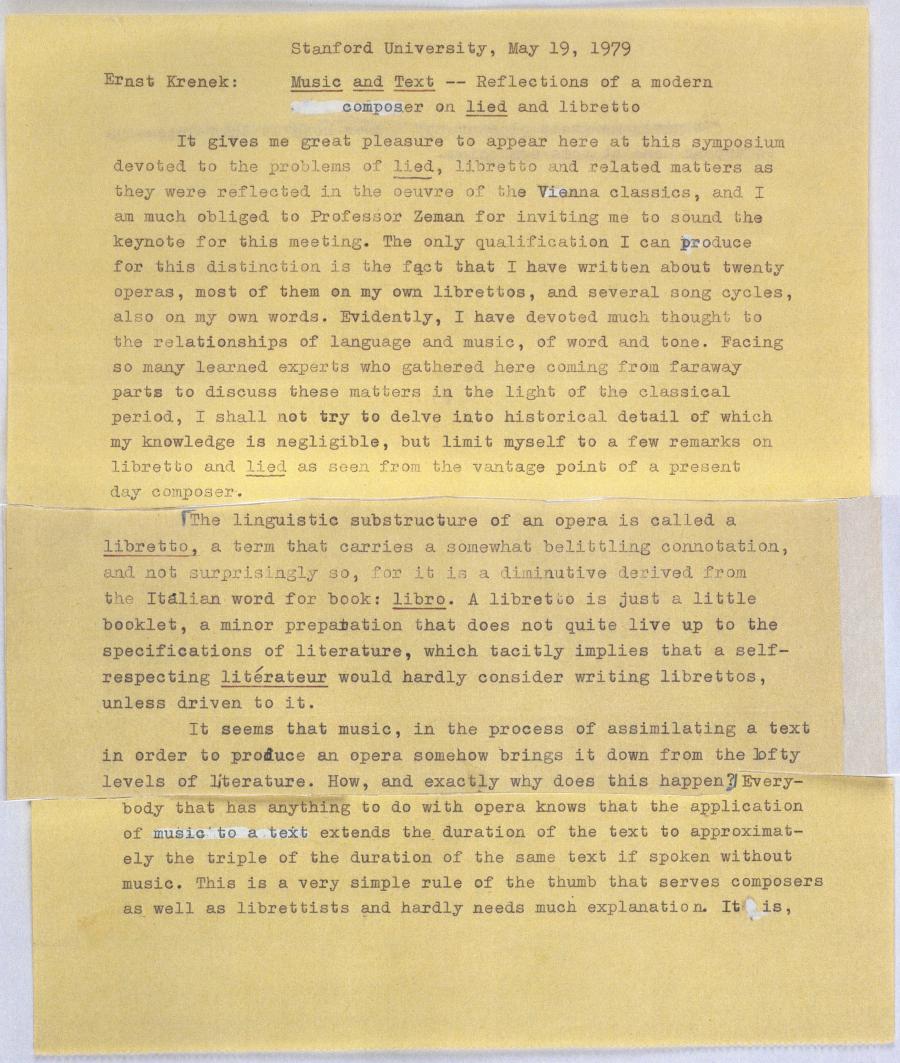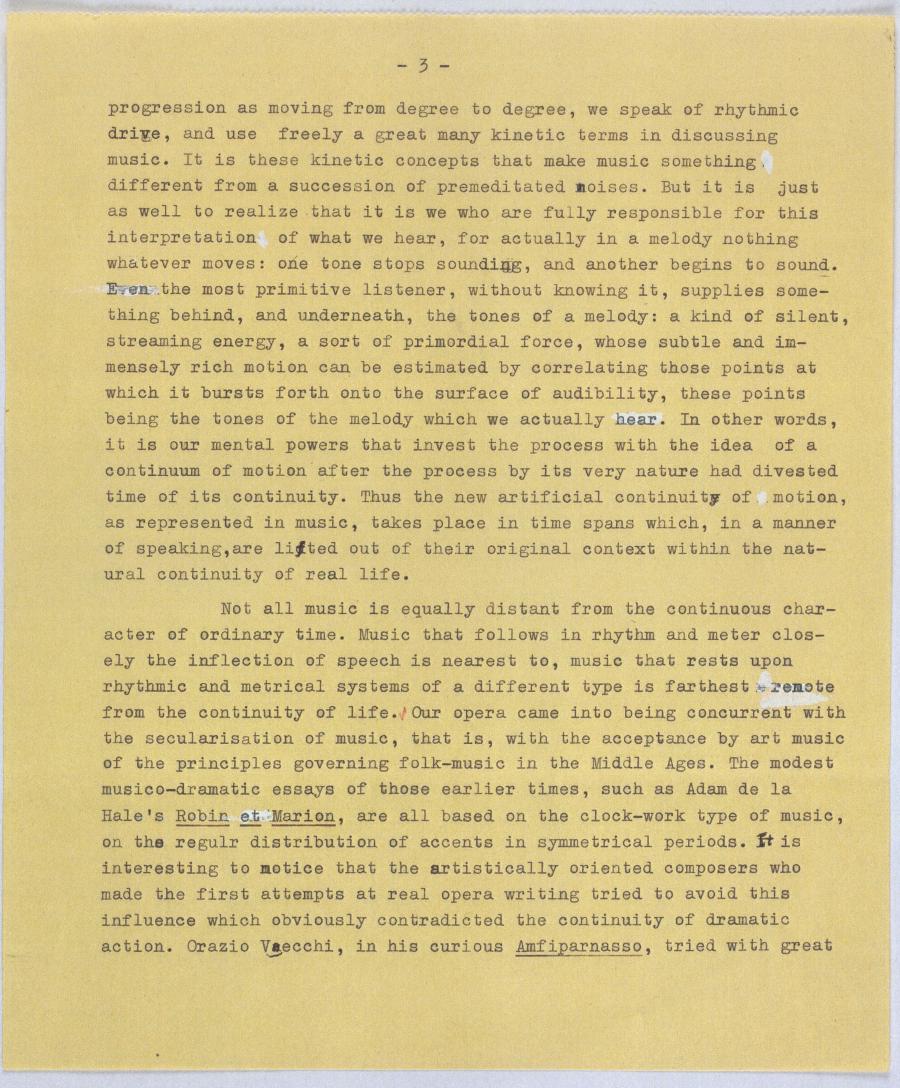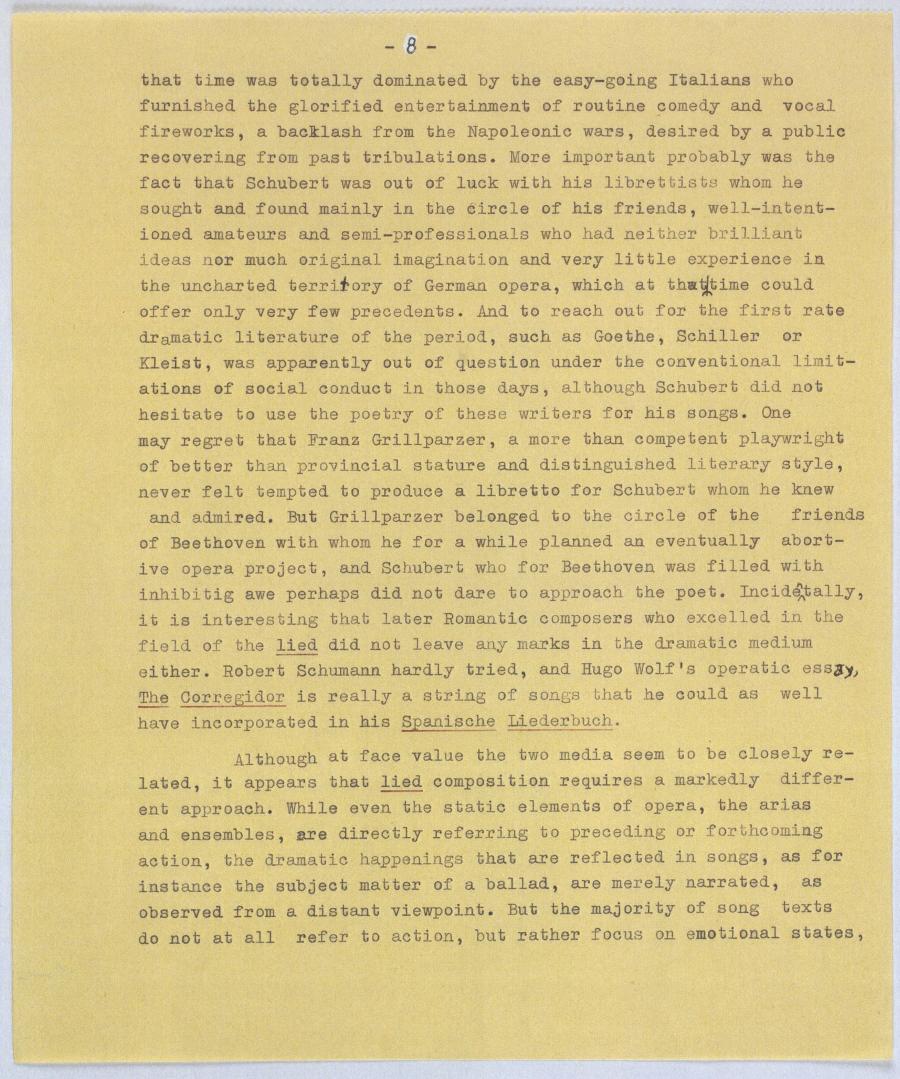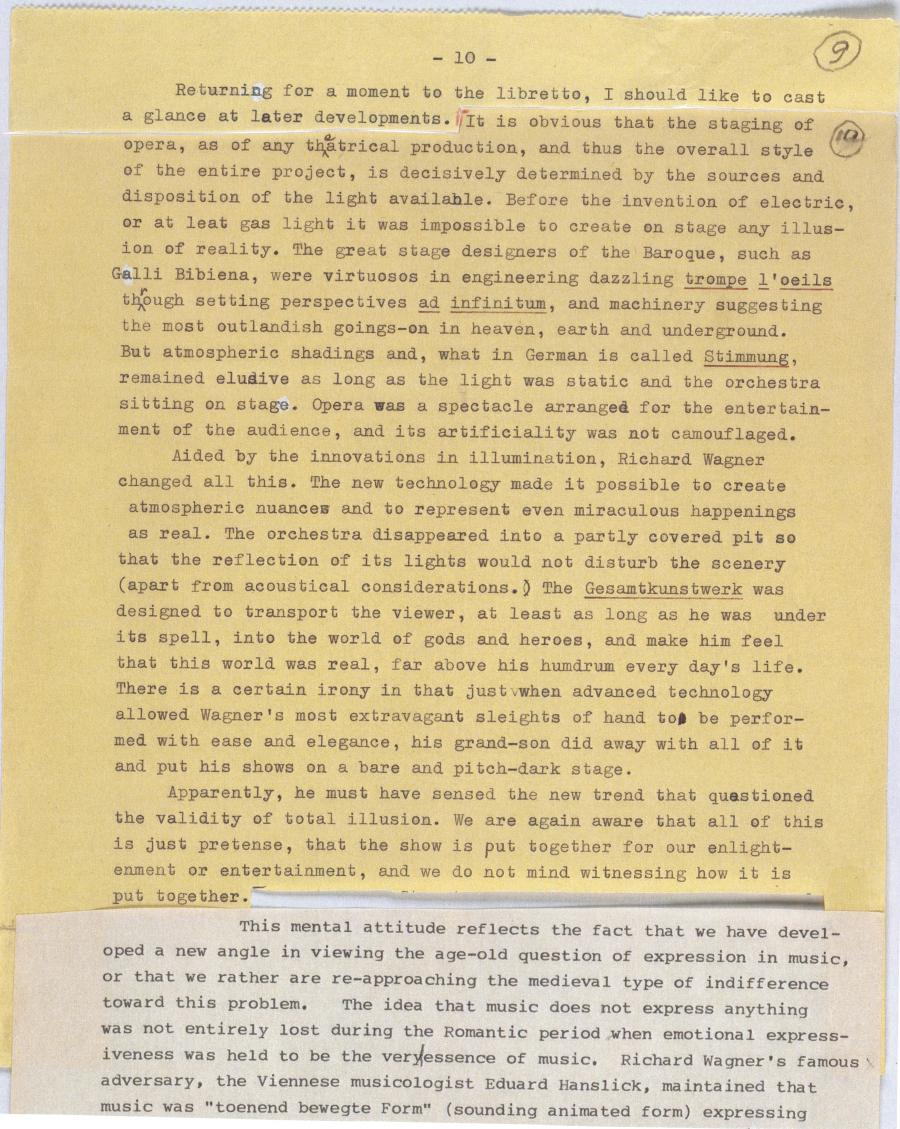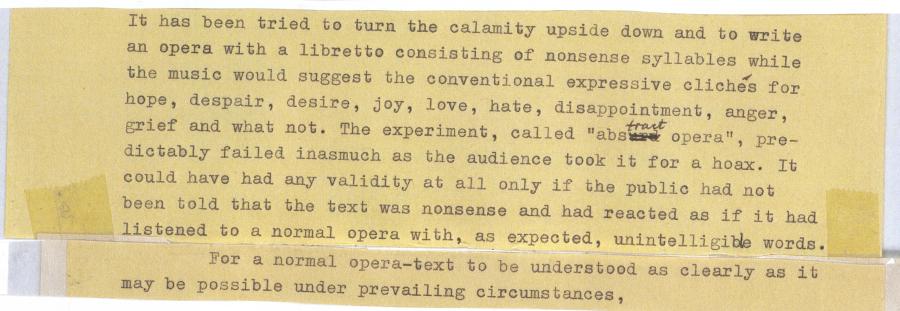Music and Text -- Reflections of a modern Composer on Lied and Libretto
Abstract
Für das vom Wiener Literaturwissenschaftler Herbert Zeman 1979 organisierte Forschungssymposium an der kalifornischen Stanford University zum Thema „Lied and Libretto of Viennese Classicism“ wurde Ernst Krenek als Austro-Kalifornier eingeladen, die Keynote-Ansprache zu halten.
In seinem Vortrag ging Krenek auf das Verhältnis von Text und Musik ein mit besonderer Aufmerksamkeit auf Fragen des Opernschaffens. Er entfaltet seine Darstellung entlang von Überlegungen zu stilistischen Entwicklungen der Gattung von ihren frühen Anfängen über Monteverdi, Mozart bis zu Wagner, geht aber auch auf Franz Schubert und dessen weniger erfolgreiches und bekanntes Opernschaffen ein.
Music
and
Text-- Reflections of a modern composer on
liedand libretto
It gives me great pleasure to appear here at this symposium
devoted to the problems of lied, libretto and related matters as
they were reflected in the oeuvre of the lied as seen from the vantage point of a present
day composer.
The linguistie substructure of an opera is called a
libretto, a term that carries a somewhat belittling connotation,
and not surprisingly so, for it is a diminutive derived from
the Italian word for book: libro. A libretto is just a little
booklet, a minor preparation that does not quite live up to the
specifications of literature, which tacitly implies that a self-
respecting litérateur would hardly consider writing librettos,
unless driven to it.
It seems that music, in the process of assimilating a text in order to produce an opera somehow brings it down from the lofty levels of literature. How, and exactly why does this happen? Every- body that has anything to do with opera knows that the application of music to a text extends the duration of the text to approximat- ely the triple of the duration of the same text if spoken without music. This is a very simple rule of the thumb that serves composers as well as librettists and hardly needs much explanation. It is,
- 2 -however, interesting to look for a moment into the aesthetical implications of this condition.
We know that opera very early developed a tendency towards discriminating sharply between two types of setting the words: on the one hand the recitative, on the other hand the integrated mus- ical form, such as aria, duet, or other kinds of ensemble singing. As far as the time factor is concerned, the recitative section ap- proaches most closely the natural speed of the spoken word, so that the action carried on in those sections is hardly slower than it would be without music, whereas in the integrated musical forms, especially in the ensembles, action frequently comes to a complete standstill when the singers are not even communicating with each other, but presenting simultaneous monologues, a styl- istic convention of opera which audiences have learned to accept without questioning its obvious absurdity.
Opera is a particularly stylized form of dramatic present-
ation because it coordinates two time-mechanisms of entirely
progression as moving from degree to degree, we speak of rhythmic drive, and use freely a great many kinetic terms in discussing music. It is these kinetic concepts that make music something different from a succession of premeditated noises. But it is just as well to realize that it is we who are fully responsible for this interpretation of what we hear, for actually in a melody nothing whatever moves: one tone stops sounding, and another begins to sound. Even the most primitive listener, without knowing it, supplies some- thing behind, and underneath, the tones of a melody: a kind of silent, streaming energy, a sort of primordial force, whose subtle and im- mensely rich motion can be estimated by correlating those points at which it bursts forth onto the surface of audibility, these points being the tones of the melody which we actually hear. In other words, it is our mental powers that invest the process with the idea of a continuum of motion after the process by its very nature had divested time of its continuity. Thus the new artificial continuity of motion as represented in music, takes place in time spans which, in a manner of speaking, are lifted out of their original context within the nat- ural continuity of real life.
Not all music is equally distant from the continuous char-
acter of ordinary time. Music that follows in rhythm and meter clos-
ely the inflection of speech is nearest to, music that rests upon
rhythmic and metrical systems of a different type is farthest remote
from the continuity of life. Our opera came into being concurrent with
the secularisation of music, that is, with the acceptance by art music
of the principles governing folk music in the Middle Ages. The modest
musico-dramatic essays of those earlier times, such as Robin et Marion, are all based on the clock-work type of music,
on the regulr distribution of accents in symmetrical periods. It is
interesting to notice that the artistically oriented composers who
made the first attempts at real opera writing tried to avoid this
influence which obviously contradicted the continuity of dramatic
action. Amfiparnasso, tried with great
ingenuity to derive whatever he could of continuity from a flexible
handling of the madrigal style; that is, technically speaking, he
mustered whatever was left in the madrigal style of free accent dis-
tribution in order to match the quick pace of the comedy. Orfeo come closest to
a kind of grafting principles of the ancient, free Gregorian decla-
mation onto the new harmonic style, and it is precisely in this re-
spect that these composers also come closest to the diction of the
Greek tragedy which they so assiduously strove to revive. However, the
future of opera lay elsewhere. It was the same
While during arias, and especially in ensembles the visible
progress of the dramatic vehicle is interrupted
movements the magnitude of which in a medium consistent with ord- inary time would require lengthy psychological preparation. An emotional about-face, for instance, which might appear on the verge of the ludicrous in a spoken dialogue, or even in recitative treat- ment, can be made entirely convincing in a coherent musical struct- ure in which the decisive turning point is presented as inevitable crisis brought about through the stringent logic of the musical process.
From all this it will appear fairly obvious that the ex-
pectations a composer entertains toward his libretto are highly
specific and in many respects different from the working principles
of the playwright so that he eventually turns to a specialist who
will adapt existing plays or make new ones according to specific-
ations. Many professional librettists were hackwriters who would
produce librettos by the ream although some of them were imagin-
ative dramatists, as, for instance, L'incoronazionedi Poppeaeadesecco recitative and integrated musical forms so that the mech-
anics of time perception that I discussed earlier were not so con-
spicuous any longer. Since music was freed of the obligatory period-
ical patterns, versification, heretofore deemed indispensable, also
became optional. It is perhaps these circumstances that in modern
times have encouraged even some writers and poets of literary fame,
such as
that only they can control them to full satisfaction.
Another point is that composers eventually have become more
aware of having their own ideas about the content of their operas
bel canto aficion-
ados opera was reduced to efoed
a necessary condition, of course, is that operas be produced
in the language of the presumptive audience. It has been a prejudice
of long standing, fostered by the attitudes of mainly Italian voice
teachers, that operatic music is so identified with the sounds of
the original language - especially as long as this language is
Italian (on the assumption that worthwhile operas could not be
written in any other language) that any translation would destroy
the unique charm of the work. Obviously this argument has no merits
whatever. It has prevailed in this country for a long time because
it appealed to the dominating puritanic mentality that regarded
opera as a morally dubious product imported for the entertainment
of the jaded wealthy that could be tolerated at least as long as
one could not understand what those clows were singing about.
Fortunately this has rapidly changed in our time while,
defended by exhibiting the perfectly atrocious translations that have littered opera houses all through the nineteenth century up to our own time. Obviously this would not have to be so, and it happened only because competent people found the task below their dignity. Fortunately, this too has changed, and more respectable writers have come to the rescue of this neglected field.
During the period to which this symposium is devoting
special attention Fidelio, an opera that has remained a moving
humanitarian document not only because of some powerful music of
great emotional impact, but also because of the seriousness and
dignity of its dramatic intent. Granting this, on has to admit that
the libretto suffers from the childish and unbelievable trans-
vestite charade by which the librettist seems to have tried to
make a lofty drama a little entertaining, introducing elements of
routine intrigue. It would appear that
Don
Giovanni
that time was totally dominated by the easy-going Italians who
furnished the glorified entertainment of routine comedy and vocal
fireworks, a backlash from the Napoleonic wars, desired by a public
recovering from past tribulations. More important probably was the
fact that lied did not leave any marks in the dramatic medium
either. The CorregidorSpanische Liederbuch
Although at face value the two media seem to be closely re-
lated, it appears that lied composition requires a markedly differ-
ent approach. While even the static elements of opera, the arias
and ensembles, are directly referring to preceding or forthcoming
action, the dramatic happenings that are reflected in songs, as for
instance the subject matter of a ballad, are merely narrated, as
observed from a distant viewpoint. But the majority of song texts
do not at all refer to action, but rather focus on emotional states,
ideas occupying the mind, images of nature, atmospheric vibrations
of the e, contemplation of all this, and many other intangibles.
All these manifold and fleeting concepts are lifted out of the con-
text of real time and pinned down as in an instantaneous photo-
graphic picture, as in a snapshot.
Considering the staggering number of lieder and
their frequently rapid succession in the sequence of his works, we
must ascribe to him an extraordinary sensitivity for the stimuli
emanating from a poem and triggering his creative impulse as well
as a minimum reaction time between reading the poem and conceiving
its musical Gestalt. The camera of his mind apparently was constantly
searching for poetic images and scenes that would reflect at any
given moment some facet of his personality so that he could identify
with them and immediately produce a musical quasi-negative of the
image that had kindled his imagination. The term "snapshot" which
I have just used brings to mind concept lied
to new, spectacular life. Of course, the song, the vocal solo, the
lyrical monologue had existed since time immemorial when, long before
opera, Meister- and Minnesingers, Troubadours and Trouvères had ex-
pressed themselves in this way. It seems that opera interrupted the
tradition of the solo song when the virtuoso vocal display of the
aria absorbed the public attention. It was certain
Returning for a moment to the libretto, I should like to cast
a glance at later developments. It is obvious that the staging of
opera, as of any trompe l'oeils
ad infinitum, and machinery suggesting
the most outlandish goings-on in heaven, earth and underground.
But atmospheric shadings and, what in German is called Stimmung,
remained elusive as long as the light was static and the orchestra
sitting on stage. Opera was a spectacle arranged for the entertain-
ment of the audience, and its artificiality was not camouflaged.
Aided by the innovations in illumination, Gesamtkunstwerk was
designed to transport the viewer, at least as long as he was under
its spell, into the world of gods and heroes, and make him feel
that this world was real, far above his hundrum every day's life.
There is a certain irony in that just when advanced technology
allowed
Apparently, he must have sensed the new trend that questioned the validity of total illusion. We are again aware that all of this is just pretense, that the show is put together for our enlight- enment or entertainment, and we do not mind witnessing how it is put together.
This vision of dramatic
processes taking place simultaneously on various planes and levels
and their integration with complex musical processes requires very
accurate coordinating and synchronizing all parameters, which
again recommends to some composers taking control of all aspects
of such a project and writing their own librettos. [Not beeing]
equipped with a crystal ball, I shall refrain from making any
guesses as to how it may go on from here - for such would also
be far beyond the framework of the present symposium.
When, in 1930, I asked the great Viennese satirist and
poet, Quintina, a brief can-
tata for solo voice, with the lines:
Sprache schenkt Musik das Wort, wird stumm im dunklen Klang, im Ton verweht ihr Sinn. Language lends the word to music, becomes mute in the dark sound, in tones it loses its meaning. But, then, if music makes language mute, it says at the end of the poem: Es gellt aus Musik der Stummheit Schrei ins Ohr. Der Trauer bietet Trost ihr Klang am Ende. Absurd, prae-logisch, steht Musik am Anfang. Out of music the cry of muteness pierces the ear. Solace to the sorrow is extended by sound in the end. Absurd, pre-logical, music stands at the beginning. So much for the mystery that cloaks the relation of word and tone.
In conclusion let me say that I hope that some of these
scattered remarks may offer you a few cues for the deliberations
upon which you are about to embark. It gives me great satisfaction
that my old homeland,
